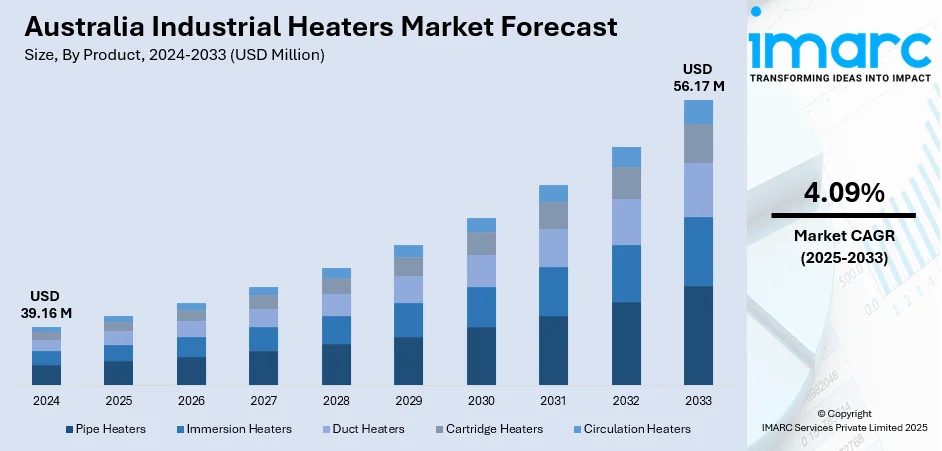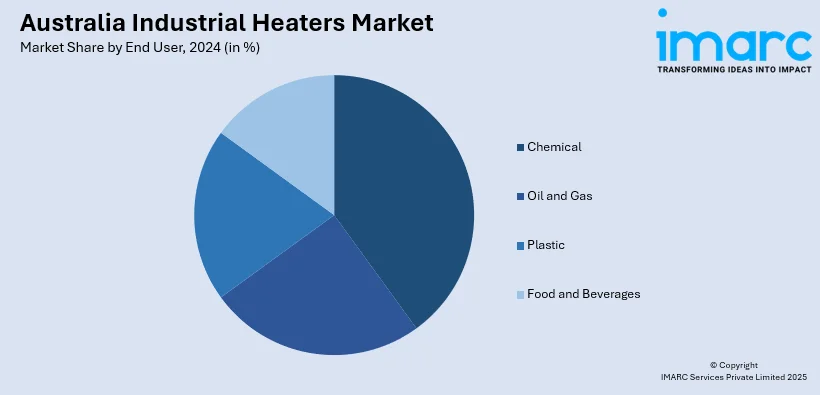
Australia Industrial Heaters Market Size, Share, Trends and Forecast by Product, Technology, End User, and Region, 2025-2033
Australia Industrial Heaters Market Overview:
The Australia industrial heaters market size reached USD 39.16 Million in 2024. Looking forward, IMARC Group expects the market to reach USD 56.17 Million by 2033, exhibiting a growth rate (CAGR) of 4.09% during 2025-2033. Increasing demand for energy-efficient products, expansion in mining and resource industries, and stringent environmental regulations are drivers promoting the market growth. Furthermore, innovation in heater design, industrial automation expansion, higher need for high-performance heat in food processing and pharmaceuticals, and smart heating system uptake are stimulating the market growth. Moreover, industrial facility growth, retrofitting, and system upgrade, health and safety needs, and global warming prevention for data centers are driving the Australia industrial heaters market share.
|
Report Attribute
|
Key Statistics
|
|---|---|
|
Base Year
|
2024
|
|
Forecast Years
|
2025-2033
|
|
Historical Years
|
2019-2024
|
| Market Size in 2024 | USD 39.16 Million |
| Market Forecast in 2033 | USD 56.17 Million |
| Market Growth Rate 2025-2033 | 4.09% |
Australia Industrial Heaters Market Trends:
Energy-Saving Heating Alternatives
In Australia, there is a clear trend toward adopting energy-efficient heating technologies across industrial sectors. With rising energy costs continuing to hike up, businesses are looking for ways to limit the amount of energy they consume in order to reduce the operating costs. The need for greater energy efficiency has been driving the utilization of cutting-edge industrial heaters. These new technologies are designed to optimize the use of energy, eliminating wastage but providing effective heating. As an example, more recent heaters involve better insulation and heat exchangers to retain more heat, and intelligent features are introduced to modulate the temperature to fit actual needs, reducing energy consumption even further. Manufacturing, mining, and chemicals sectors, usually high-energy consumers, benefit most from these systems. In addition, energy-efficient heaters help businesses comply with the environmental laws set by the Australian government in an attempt to reduce carbon emissions. By using less energy and fewer emissions, businesses save on finances while at the same time headed towards their sustainability goals, which is further driving the Australia industrial heaters market growth.

To get more information on this market, Request Sample
Growth in Resource and Mining Sectors
The resource and mining industries in Australia are prime movers for the industrial heaters market. As one of the world's biggest exporters of minerals like coal, iron ore, and gold, the mining industry in Australia demands top-quality industrial heaters. Industrial heaters are used in various critical applications in the mining sector, such as drying materials, controlling temperatures in mineral processing, and protecting equipment against extreme weather conditions. As the mining industry grows with the world's growing need for energy and raw materials, so does the need for reliable heating systems. Also, because mines are often situated in far-flung places with harsh climates, reliable heat is needed to maintain equipment operation and guarantee continuous operations. Heaters also serve to underpin industries like metal processing and oil extraction, where temperature is of paramount importance to the success of the operations. In 2024, the Western Australian government announced AUD 40 million in funding to support mining innovation and critical minerals exploration, boosting demand for high-performance industrial heating solutions. The continued growth of the mining and resource industries will more than likely drive demand for industrial heaters, and they will continue to be a core part of Australia's industrial infrastructure.
Strict Environmental Regulations and Emphasis on Sustainability
Australia's strong emphasis on environmental sustainability has been a driving force behind the industrial heaters market. Australia has enforced strict environmental regulations that compel industries to adopt more energy-efficient and green practices. This has led various companies to seek out industrial heaters with low energy consumption and carbon emissions. With industries being compelled to reduce their ecological impact, they are investing heavily in heating systems that not only turn green but also fit into overall sustainability targets. Australian policies, such as carbon pricing and renewable energy policies, push companies to implement equipment that allows them to comply with environmental standards without compromising operational efficiency. This focus on sustainability is especially critical in markets like food processing, pharmaceuticals, and chemical manufacturing, where industrial heaters must provide performance alongside environmental compatibility. As regulations tighten and sustainability becomes more important, the demand for environmentally compatible industrial heaters should continue to grow.
Australia Industrial Heaters Market Segmentation:
IMARC Group provides an analysis of the key trends in each segment of the market, along with forecasts at the country and regional levels for 2025-2033. Our report has categorized the market based on product, technology, and end user.
Product Insights:
- Pipe Heaters
- Immersion Heaters
- Duct Heaters
- Cartridge Heaters
- Circulation Heaters
The report has provided a detailed breakup and analysis of the market based on the product. This includes pipe heaters, immersion heaters, duct heaters, cartridge heaters, and circulation heaters.
Technology Insights:
- Electric Based
- Steam Based
- Hybrid Based
A detailed breakup and analysis of the market based on the technology have also been provided in the report. This includes electric-based, steam-based, and hybrid-based technologies.
End User Insights:

- Chemical
- Oil and Gas
- Plastic
- Food and Beverages
The report has provided a detailed breakup and analysis of the market based on the end-user. This includes chemical, oil and gas, plastic, and food and beverages.
Regional Insights:
- Australia Capital Territory & New South Wales
- Victoria & Tasmania
- Queensland
- Northern Territory & Southern Australia
- Western Australia
The report has also provided a comprehensive analysis of all the major regional markets, which include Australia Capital Territory & New South Wales, Victoria & Tasmania, Queensland, Northern Territory & Southern Australia, and Western Australia.
Competitive Landscape:
The market research report has also provided a comprehensive analysis of the competitive landscape. Competitive analysis such as market structure, key player positioning, top winning strategies, competitive dashboard, and company evaluation quadrant has been covered in the report. Also, detailed profiles of all major companies have been provided.
Australia Industrial Heaters Market News:
- In 2023, A2EP established the Australian Heat Pump Roundtable, bringing together industry leaders and government representatives to accelerate the transition to heat pumps in Australia's commercial and industrial sectors
Australia Industrial Heaters Market Report Coverage:
| Report Features | Details |
|---|---|
| Base Year of the Analysis | 2024 |
| Historical Period | 2019-2024 |
| Forecast Period | 2025-2033 |
| Units | Million USD |
| Scope of the Report |
Exploration of Historical Trends and Market Outlook, Industry Catalysts and Challenges, Segment-Wise Historical and Future Market Assessment:
|
| Products Covered | Pipe Heaters, Immersion Heaters, Duct Heaters, Cartridge Heaters, Circulation Heaters |
| Technologies Covered | Electric Based, Steam Based, Hybrid Based |
| End User Covered | Chemical, Oil and Gas, Plastic, Food and Beverages |
| Regions Covered | Australia Capital Territory & New South Wales, Victoria & Tasmania, Queensland, Northern Territory & Southern Australia, Western Australia |
| Customization Scope | 10% Free Customization |
| Post-Sale Analyst Support | 10-12 Weeks |
| Delivery Format | PDF and Excel through Email (We can also provide the editable version of the report in PPT/Word format on special request) |
Key Questions Answered in This Report:
- How has the Australia industrial heaters market performed so far and how will it perform in the coming years?
- What is the breakup of the Australia industrial heaters market on the basis of product?
- What is the breakup of the Australia industrial heaters market on the basis of technology?
- What is the breakup of the Australia industrial heaters market on the basis of end user?
- What is the breakup of the Australia industrial heaters market on the basis of region?
- What are the various stages in the value chain of the Australia industrial heaters market?
- What are the key driving factors and challenges in the Australia industrial heaters market?
- What is the structure of the Australia industrial heaters market and who are the key players?
- What is the degree of competition in the Australia industrial heaters market?
Key Benefits for Stakeholders:
- IMARC’s industry report offers a comprehensive quantitative analysis of various market segments, historical and current market trends, market forecasts, and dynamics of the Australia industrial heaters market from 2019-2033.
- The research report provides the latest information on the market drivers, challenges, and opportunities in the Australia industrial heaters market.
- Porter's five forces analysis assist stakeholders in assessing the impact of new entrants, competitive rivalry, supplier power, buyer power, and the threat of substitution. It helps stakeholders to analyze the level of competition within the Australia industrial heaters industry and its attractiveness.
- Competitive landscape allows stakeholders to understand their competitive environment and provides an insight into the current positions of key players in the market.
Need more help?
- Speak to our experienced analysts for insights on the current market scenarios.
- Include additional segments and countries to customize the report as per your requirement.
- Gain an unparalleled competitive advantage in your domain by understanding how to utilize the report and positively impacting your operations and revenue.
- For further assistance, please connect with our analysts.
 Request Customization
Request Customization
 Speak to an Analyst
Speak to an Analyst
 Request Brochure
Request Brochure
 Inquire Before Buying
Inquire Before Buying




.webp)




.webp)












